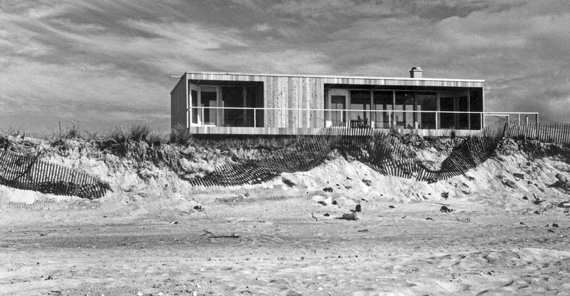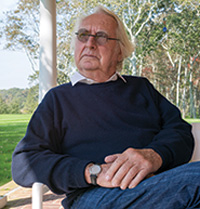The Hamptons will always have a special place in the heart of world-renowned architect Richard Meier. His East Hampton abode — a vintage 1907 farmhouse, not one of his signature white minimalist creations — is the first and only house he has ever owned. The first home he ever designed, the Lambert House, was built on nearby Fire Island. It was constructed in the early 1960s, for $11,000, by a firm that had previously only built log houses.
Meier went on to design four homes in the Hamptons, two of which were built in the late 1960s, and one that is currently under construction in Southampton. His first two notable East End residences, the Hoffman house and the Saltzman house, are both pristine structures that remain local landmarks in the Hamptons after half a century.
For this issue of the Hamptons Market Report, The Real Deal chatted with the Pritzker Prize–winning starchitect. (Incidentally, Meier himself said he’s not entirely sure what the term “starchitect” means.) Here are his views on contemporary architecture, Hamptons McMansions and his latest project — an all-black tower on First Avenue in Manhattan.
What do you think of modern design today?
I think today there’s great contemporary architecture being done all over the world. Young architects these days especially feel that their work should be contemporary, that how it’s built should be related to where it is.
I think [architecture] is more visible now. There is more public awareness about architecture today than ever before, and I think people appreciate good-quality contemporary architecture.
What are some of the big design trends you’re into right now? How about ones you don’t like?
Today, everyone is thinking about the context in which they’re working. They’re thinking about energy, and ways to use energy, and conserve energy — and that goes without saying almost.
What I don’t like are things that are out of scale. Whether it’s a huge house that seems unnecessarily big, or it’s a tall building that’s out of scale with its surroundings, I think that the relationship of scale to place is very important. High-rises can have an effect on what happens at the ground level. Public spaces are there in any building project, so it’s not just about the building.
I sit in my office on 10th Avenue in Manhattan, and I look out the window. The Empire State Building used to be such an icon. Today, it’s almost [eclipsed] by some of the huge buildings around it that I don’t know are necessary.
Do you ever adjust your work to match the current climate of architecture?
Certainly not. I respect the work of a lot of people, but it doesn’t affect what we do.
Today, I think things go a little faster. Perhaps it has to do with the use of the computer. Whereas something might have taken five years, from start to finish, 20 years ago, it now takes three. In that regard, things have changed a little bit for us.
We know you’re a big fan of the color white. But now you’re working on an all-black tower on First Avenue. How did you come up with the concept?
When I first started working with Sheldon Solow, he said to me, “Now, Richard, I love your work, but I want you to do a black building.” And I thought about it for a while, and I said, “Why not? I’m known for the white buildings, but we could do a quality dark building as well.”
I think this building is different from a lot of my work, but who knows what we’ll do in the future. I think it’s really going to be a very unusual building, the way it’s detailed, the way it’s going to be constructed, like the glass details on the facade and the lobby. I was focused on this building certainly being just south of the UN building, and I thought of the relationship between the UN building — which I think is wonderful — and this new building. They sort of create, architecturally, a wonderful neighborhood.
You have your own house in East Hampton. What’s remarkable to you about the Hamptons and the architecture of its houses?
Well, one of the great things about the Hamptons is the wonderful scale [of the homes], most of which are well-sized and respectful of their neighbors. What upsets me is when you see some of these huge houses that just seem so enormous. You wonder, “Why do they need to be so big?” For the most part, there’s a certain scale and quality out here that should be respected.

The first home Richard Meier ever designed in 1962
If you were commissioned to design another house in the Hamptons, what would be your vision for it?
It really depends on where it’s located, what the site is like, what surrounds it and what orientation it has, so it’s hard to say until I knew where it was going to be built. It’d be different if it were in a wooded area as opposed to being out on the ocean.
But it probably would be white.
What are some of your favorite projects you’ve worked on in recent years?
I did a museum in Rome, and also a church in Rome, as well as a hotel in South Korea, and we’re working on two buildings in Tokyo. As I mentioned, the building on First Avenue just started construction. We’re finishing a house in Switzerland, and we’re doing a residential building in Colombia. We’re very fortunate to get to work in different places.
Of course, I’m always happy about the most recent one, right now being the building on First Avenue. And the hotel we just created in South Korea, which is on the water. It’s interesting that so much of the work we’ve done is related to the water, and for that I feel very lucky, because on the water you have that openness and the space, and the quality of light is different.
How has your work evolved?
You know, it’s always been concerned with light, with space, with the quality of spaces we make. The context in which we’ve worked, there are certain givens to all of the projects, no matter large or small. I’m very concerned about making a place that is not just for the owner but gives something to the community.
Are there architectural decisions you regret making?
No.
Are you still making collages?
Actually, I am. I make collages in two ways: I’ve now completed 180 books of collages, and also I’m working on boards. And also encaustic art, which is a process using wax.
Have you taken on any new hobbies in recent years?
No, my hobbies are painting, doing collages. I do watercolors, plus gardening. Sometimes I paint the beach, the light off the ocean. Sometimes I paint what’s around my house here in East Hampton.
Where are some of your favorite places to eat, drink and shop in the Hamptons?
I spend an awful lot of time at home. My favorite place to eat is at home. There are so many places to eat out here, but sometimes it’s a problem, because there are even more people going out for dinner than there are restaurants to accommodate them. And most of them are good. But I’d rather barbecue something on the grill here.
Tell us about the first house you ever constructed, the modular beach house you designed and built on Fire Island for around $11,000. How much did you get paid for that job?
I think I got a couple hundred dollars.
Editor’s note: An earlier version of this article said that Meier’s firm was working on a residential project in Bolivia; the project is in Colombia.
